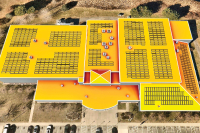Landowner dismayed N.C. 107 bridge widening will claim archaeology site
A Cherokee archaeological site spanning from at least 6,000 years ago to the 18th century stands in the way of bridge widening project over the Tuckasegee River in Jackson County.
Plans call for widening the N.C. 107 bridge over the river from its existing width of just 20 feet to 50 feet at a cost of $4.2 million. The new bridge will be three lanes with shoulders and a sidewalk.
Landowners and the N.C. Department of Transportation are at odds over the project. The archaeological site is on land owned by the Moses family for 120 years. The family has taken pride in the site and hosted university sponsored archaeological digs on its property through the years.
While a wider bridge has been in the making for more than a decade, plans initially called for building a new bridge in the same place, leaving the archaeological site untouched. Plans were altered in 2007, calling not only for a much larger footprint but also shifting the bridge over to sit on top of the site.
The DOT failed to notify the landowners of the change until now, according to Cherrie Moses of Tuckasegee.
The family got a phone call a few weeks ago from DOT to discuss purchasing their property for the widening.
Related Items
“We were in total shock,” said Moses, 52, a retired school teacher. “This is the first time we are hearing about this, and it is already a done deal. It was like all you need to do is sign on the dotted line, and the bulldozers are ready.”
Since 1997, Moses said she was told the site would be protected.
“The plans that my family had been given stated that the bridge was going back basically where it is, that the site would not be compromised,” Moses said.
Pam Williams, a bridge project planning engineer, said the Moses family was made aware of the new plan, but they must not have fully understood.
The DOT was well aware of the archaeological site in the path of the bridge widening. It plans to excavate the site first and document all the artifacts that are found, said Matt Wilkerson, a DOT archaeologist.
Wilkerson said one of the most intriguing aspects of the site is relatively recent Cherokee occupation dating to the 1700s. One house site was excavated in an archaeology dig by a university team a few decades ago, and Wilkerson thinks there may be more.
The site won’t be destroyed by the bridge, Wilkerson said. If anything, the bridge project will allow the secrets of the site to be uncovered with an archaeological dig.
In crafting an excavation plan, DOT consulted with the Eastern Band of Cherokee Indians and the state historic preservation office. Both signed off on the project with the caveat that the artifacts be saved in advance of the bulldozers.
Moses doesn’t understand why they included everyone except the landowners.
“That is not right. We would have liked to been in on the meeting and voiced our concerns,” said Moses, who also happens to be the chair of the Jackson County Historic Preservation Commission.
The site is on its way to being listed on the National Historic Register after being recommended by the DOT archaeologist.
Federal law requires a formal public process when impacting sites that are eligible for the National Register, but no one ever sought out participation by the Moses family.
Chain of events
The bridge was targeted for replacement more than a decade ago due to its age and narrow width. It is technically deemed “structurally deficient” and “functionally obsolete.” It is still safe, Williams said, but won’t stay that way forever, and maintenance costs will increase.
The existing bridge has 10-foot lanes and no shoulders.
“We have had several side swipes over the past few years,” Williams said.
The new bridge will have three 12-foot lanes, 4-foot shoulders that will double as bike lanes and a sidewalk on one side.
It will also have a left-turn lane for Shook Cove Road, which sits 100 feet from the bridge. The turn lane will be 200 feet long in all. Some left-turn lanes may only be 50 feet — just long enough for a couple of cars to queue up while waiting to make a left. Why is Shook Cove’s turn lane so long?
“There are a lot of variables actually to determine how much traffic would back up on the main line,” Williams said.
Williams cited an increase in development up Shook Cove as justifying the turn lane. Traffic counts in 2005 showed 4,700 cars a day passing over the bridge, with 200 vehicles making a left onto Shook Cove.
Moses questioned why the new bridge has to be so wide.
“This is a massive bridge. It is not even going to fit in,” Moses said.
Moses believes the bridge was planned with the expectation that new developments would add to traffic in the future. But the once zealous plans of developers are drastically scaled back these days, Moses said.
How it will be built
Under the original plan, a temporary river crossing would be built on the Moses property to accommodate traffic while the existing bridge was demolished and built back in the same place. To protect artifacts, heavy black fabric would be laid down and fill dirt placed on top. It would all be hauled away when the project was done. That method is no longer considered sensitive enough, however, Williams said.
Instead, DOT will use the “staged construction” method. Traffic will continue to flow on the existing bridge while the new bridge is built alongside it. Then traffic will shift to the new bridge while the old one is torn down and the other half of the new bridge built in its place.
Williams said there were two attempts to share the new plan with the public. One was a newsletter sent to property owners in December 2007. While the newsletter announces that the bridge will use a “staged construction method,” it fails to explain that such a method necessitates a larger bridge footprint.
“Reading the literature and having someone sit down with you and explain the plans are two different things,” Williams said.
The other outreach by the DOT was a public meeting in early 2008 on upgrades to N.C. 107, specifically lane widening and the new shoulders through the Tuckasegee community. Williams went to the meeting with the bridge plans in hand expecting residents would ask about it as part of the larger N.C. 107 upgrades.
Williams also said she twice mentioned “data recovery” to Moses in emails. But just as the term “staged construction” means little to the lay person, Moses did not realize that references to “data recovery” translated to “archaeological dig,” meaning the bridge’s footprint would consume the site and require an excavation in advance of construction.
But, by the same token, the DOT didn’t know exactly where the new footprint would be until now.
“We can’t sit down and tell them how much land we are taking until we get the design plans done,” Williams said. And at that point, property owners are contacted about buying right of way.
More information:
Construction of a wider bridge over the Tuckasegee on N.C. 107 could start by spring of 2011. The project would take 18 months. Two lanes of traffic — one in each direction — would remain open throughout.









